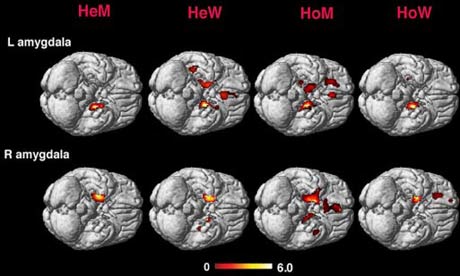Gay men and heterosexual women have similarly shaped brains, research shows
· Lesbians and heterosexual men show same pattern
· Findings may throw light on depression and autism
- Tuesday June 17 2008

Brain scans showing electrical activity according to sexuality
Striking similarities between the brains of gay men and straight women have been discovered by neuroscientists, offering fresh evidence that sexual orientation is hardwired into our neural circuitry.
Scans reveal homosexual men and heterosexual women have symmetrical brains, with the right and left hemispheres almost exactly the same size. Conversely, lesbians and straight men have asymmetrical brains, with the right hemisphere significantly larger than the left.
Scientists at the prestigious Stockholm Brain Institute in Sweden also found certain brain circuits linked to emotional responses were the same in gay men and straight women.
The findings, published tomorrow in the US journal Proceedings of the National Academy of Sciences, suggest the biological factors that influence sexual orientation - such as exposure to testosterone in the womb - may also shape the brain's anatomy.
The study, led by the neurobiologist Ivanka Savic, builds on previous research that has identified differences in spatial and verbal abilities related to sex and sexual orientation. Tests have found gay men and straight women fare better at certain language tasks, while heterosexual men and lesbians tend to have better spatial awareness.
Savic and her colleague Per Linström took MRI brain scans of 90 volunteers who were divided into four groups of similar ages according to whether they were male, female, heterosexual or homosexual. The scans showed the right side of the brain in heterosexual men was typically 2% larger than the left. Lesbians showed a similar asymmetry, with the right hand side of the brain 1% larger than the left.
Scans on homosexual men and heterosexual women revealed both sides of the brain were the same size.
The results could explain a University of London study earlier this year that found gay men and straight women share a poor sense of direction compared with heterosexual men, and were more likely to navigate using landmarks alone.
The right hand side of the brain dominates spatial capabilities, so may be slightly more developed in heterosexual men and lesbians. An earlier study by the same team found gay men and straight women outperformed lesbians and straight men at tasks designed to test verbal fluency.
Savic's team has yet to confirm whether the differences in brain shape are responsible for sexual orientation, or are a consequence of it. To find out, they have begun another study to investigate brain symmetry in newborn babies, to see if it can be used to predict their future sexual orientation.
"These differences might be laid down during brain development in the womb, or they could happen after birth, though it could very likely be a combination of the two," said Savic.
In another series of tests, Savic and Lindström used a technique called positron emission tomography (PET) to look at brain wiring in a smaller group of volunteers. They found heterosexual women and gay men shared brain circuitry linking a region called the amygdala, which plays a key role in emotional responses, to other parts of the brain.
The research is part of a larger effort to identify differences between the male and female brain, in the hope they will shed light on why some mental disorders affect men and women differently. For example, major depressive disorders are far more common and persistent in women, while autism is around four times more common in boys than girls.
"There's a well known uneven sex distribution in the number of psychiatric disorders and trying to understand sex differences, and differences in orientation, may give you a hint of the mechanism underlying these diseases," said Savic.

Nenhum comentário:
Postar um comentário